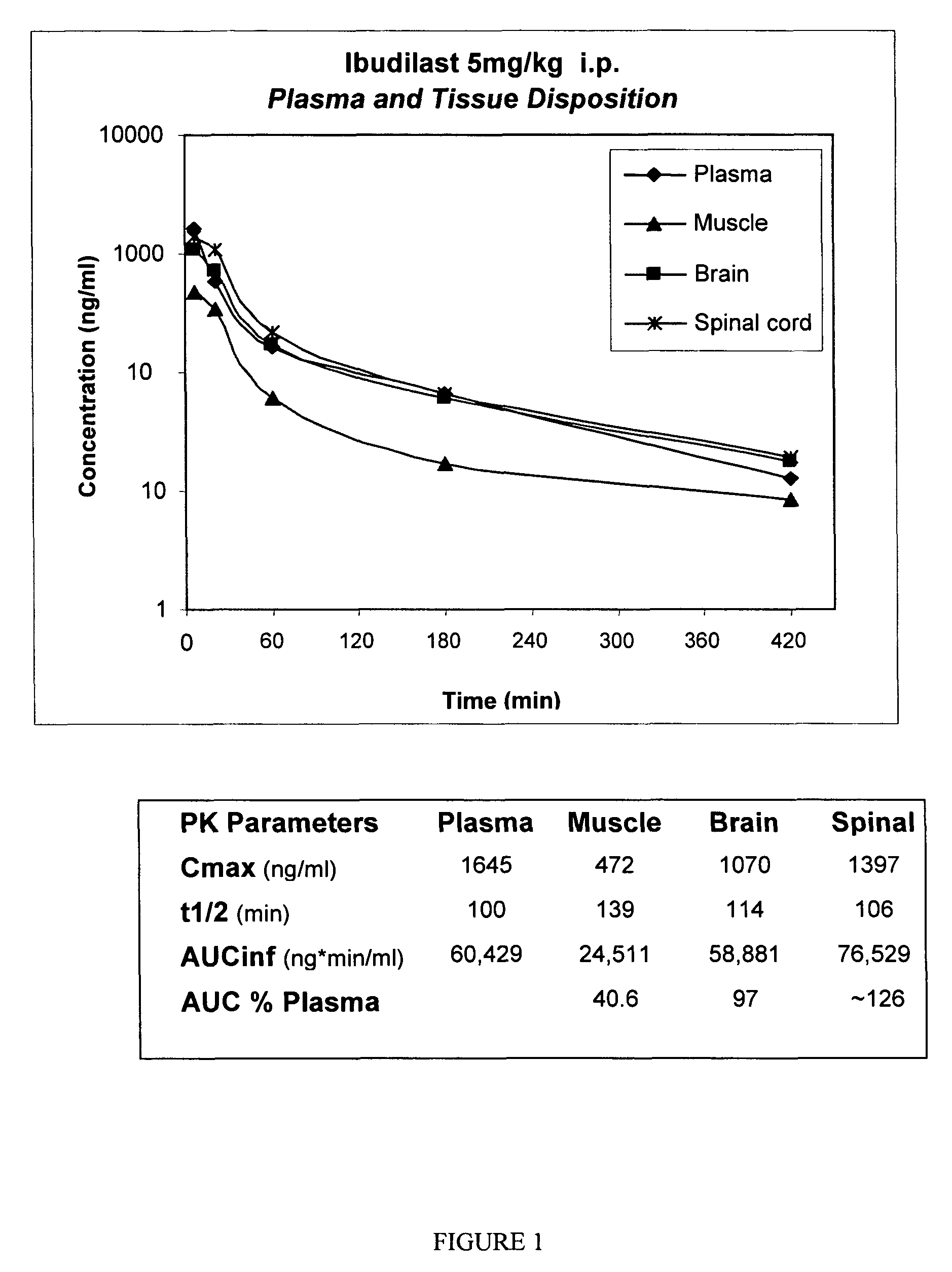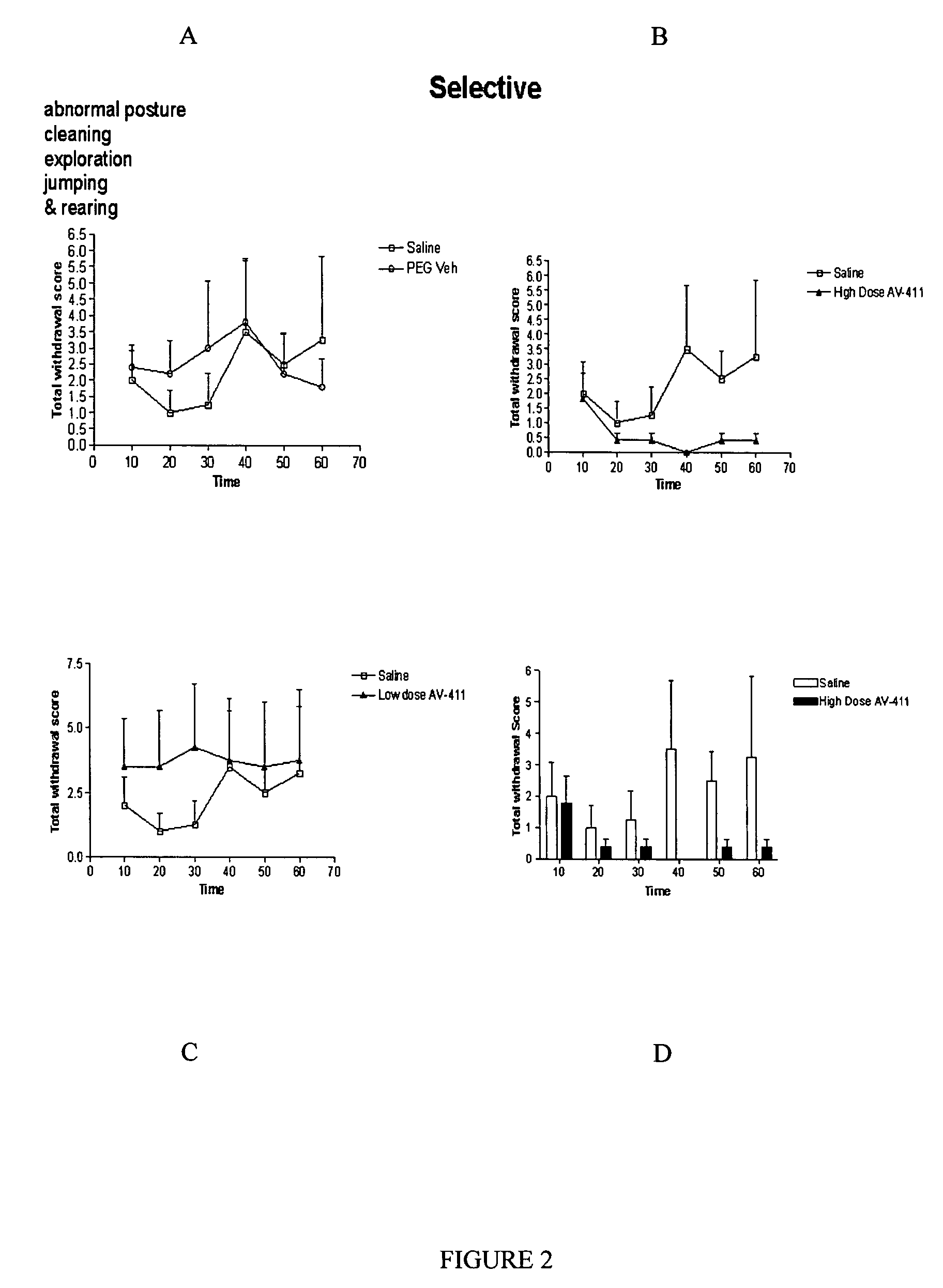Method for treating drug and behavioral addictions
a drug and behavioral addiction technology, applied in the field of drug and behavioral addiction treatment methods, can solve the problems of increasing the tolerance of a drug in a subject, affecting the treatment effect of the subject, so as to reduce or eliminate the addiction-related behavior of the subject, reduce or eliminate the tolerance to a drug, and reduce or eliminate the craving
- Summary
- Abstract
- Description
- Claims
- Application Information
AI Technical Summary
Benefits of technology
Problems solved by technology
Method used
Image
Examples
example 1
Pharmacokinetics and Tissue Distribution of Ibudilast in Rat
[0148]Ibudilast pharmacokinetics and distribution into plasma, muscle, brain, and spinal cord were assessed as follows.
Experimental Procedures
[0149]Ibudilast for administration to rats was prepared in 15% ethanol / saline. Drug stability and concentration were validated by HPLC / MS / MS.
[0150]Pathogen-free adult male Sprague-Dawley rats (280-350 g; Harlan Labs) were used in all experiments. Rats were housed in temperature (23+ / −3° C.) and light (12:12 light: dark; lights on at 0700 hr) controlled rooms with standard rodent chow and water available ad libitum. Behavioral testing was performed during the light cycle.
[0151]Rats (n=3 / group) were administered 5 mg / kg ibudilast, i.p., and plasma, muscle, brain, and spinal cord were harvested at 5, 15, 60, 180, and 420 minutes post administration. The concentration of ibudilast in tissue samples was determined as follows. A solution of ibudilast (Haorui) at 0.5 mg / ml in DMSO was used a...
example 2
Eefficacy of Ibudilast in a Rat Model of Morphine Withdrawal
[0164]A study lasting approximately one week was performed to assess the potential for ibudilast co-treatment to reduce the intensity and duration of morphine withdrawal behaviors.
Experimental procedures
[0165]Ibudilast was obtained as a pure powder from Sigma (St. Louis, Mo.) or Haorui Pharma (Edison, N.J.) and prepared daily as a solution for intraperitoneal (i.p.) administration. Previous range-finding tolerability and efficacy studies in other neurological models indicated that ibudilast was well-tolerated intraperitoneally at dose levels up to 15 mg / kg twice a day (bid) for multiple days. Ibudilast efficacy following intraperitoneal administration was representative of other systemic routes of administration such as oral treatment. An appropriate amount of ibudilast was dissolved in 100% polyethylene (PEG) 400 (Sigma) and then diluted down to a final concentration of 35% PEG400 in sterile saline (0.9% for injection).
[01...
example 3
Ibudilast Suppression of Dopamine Release in the Nucleus Accumbens
Experimental Procedures
[0173]Dopamine release in the nucleus accumbens is thought to mediate the “reward” associated with drugs of abuse. Ibudilast suppressed dopamine release in the nucleus accumbens, as measured by in vivo microdialysis. Systemic ibudilast (7.5 mg / kg b.i.d.) was co-administered with systemic morphine to rats (6 rats / group) across 5 days, using the morphine regimen described in Example 1. On the morning of the 6thday, rats received ibudilast one hour prior to initiation of baseline sampling. After 3 baseline samples (20 minute inter-sample interval), morphine was administered to all rats. Dialysis samples were collected at 20 minute intervals for 180 minutes. To test behavioral withdrawal and reversal of morphine-induced dopamine, all rats were administered the opioid antagonist naloxone after the 60 minute sample time was completed.
Results
[0174]As shown in FIG. 3, rats treated with ibudilast exhibit...
PUM
| Property | Measurement | Unit |
|---|---|---|
| particle size | aaaaa | aaaaa |
| time | aaaaa | aaaaa |
| volumes | aaaaa | aaaaa |
Abstract
Description
Claims
Application Information
 Login to View More
Login to View More - R&D
- Intellectual Property
- Life Sciences
- Materials
- Tech Scout
- Unparalleled Data Quality
- Higher Quality Content
- 60% Fewer Hallucinations
Browse by: Latest US Patents, China's latest patents, Technical Efficacy Thesaurus, Application Domain, Technology Topic, Popular Technical Reports.
© 2025 PatSnap. All rights reserved.Legal|Privacy policy|Modern Slavery Act Transparency Statement|Sitemap|About US| Contact US: help@patsnap.com



